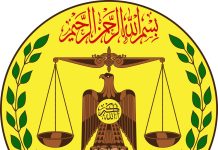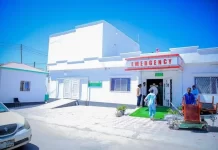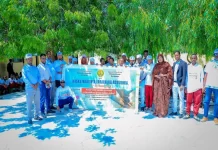“Impact of Red Sea Military Alliances on Somaliland’s Security, Economy, Diplomacy, and Regional Stability”
The Red Sea, renowned for its historical significance as a pivotal global trade route, has now become a focal point for heightened military alliances, raising concerns about maritime security.
Recent declarations by the United States regarding the formation of an international coalition to counter Houthi attacks in the Bab al-Mandab Strait have sparked discussions on the strategic importance of this region. While aimed at ensuring unhindered navigation and reinforcing regional stability, these actions underscore the intricate web of global interests within the Red Sea.
US Secretary of Defense Lloyd Austin’s announcement of a 10-country coalition aims to address recurrent Houthi assaults on vessels reportedly linked to Israel in the Red Sea. These attacks,utilizing missiles and drones targeting oil ships and containers, have amplified worries about shipping route safety. Consequently, international shipping entities are contemplating alternative routes, affecting nearly 40 percent of global trade and a significant portion of oil and liquefied natural gas transportation.
The escalating militarization across the Red Sea, housing multiple naval powers and military bases,raises concerns. Notably, the strategic interests of the United States, China, France, Turkey, and Russia vie for dominance. Russia’s collaboration with Eritrea to access the Massawa port signifies a broader effort to establish a foothold in this critical area.
However, interpretations of these alliances vary. Some experts view the US-led coalition as an extension of its influence and a shield for Israel’s security interests, relieving regional states of direct responsibilities. This move could potentially spark counter-alliances, such as an Iranian-Yemeni-Turkish coalition, possibly gaining support from China and Russia. These dynamics carry the risk of reviving a Cold War-like scenario, escalating into an international conflict, reshaping the Red
Sea region, and disrupting global navigation.
Responses to the coalition display significant divergence. Israeli Prime Minister Benjamin Netanyahu characterizes the situation as a threat to global navigation, framing it as a struggle against “Iranian terrorism.” Conversely, Iran condemns cooperation with the US coalition, justifying Houthi actions as legitimate resistance against perceived Israeli influence.
Analysts stress that beyond countering Houthi operations, the coalition seeks to safeguard strategic maritime interests in the Red Sea and Bab el-Mandeb Strait. Major Powers like Egypt, Saudi Arabia, and the UAE prioritize this region due to its significance in global trade and oil transit, indicating broader objectives that transcend immediate security concerns.
This initiative mirrors past efforts such as the Sentinel naval alliance, established in 2019 to secure territorial waters, and the European Initiative for Maritime Control in the Strait of Hormuz.
Additionally, Joint Task Force 153 operates in the Red Sea and the Gulf of Aden, demonstrating the international community’s commitment to maritime security.
Task Force 153, part of the Combined Maritime Forces, unites a consortium comprising the United Kingdom, Bahrain, Canada, France, Italy, the Netherlands, Norway, Seychelles, and Spain. Their shared objective revolves around enhancing security in the southern Red Sea and the Gulf of Aden,facilitating navigation for all nations while reinforcing regional stability and economic prosperity.
However, amidst efforts to bolster security, questions arise about the broader geopolitical landscape and the intricate regional dynamics at play. The conspicuous absence of influential regional powers like Saudi Arabia, Egypt, Djibouti, Somalia, Sudan, Kenya, Ethiopia, and Eritrea from this coalition prompts closer examination of its composition and implications for regional alignments.
Furthermore, the exclusion of China, despite its substantial economic interests in the Red Sea as part of its expansive Belt and Road Initiative, sparks discussions about potential misinterpretations of the increased allied presence in the region. Clear communication and transparent engagement among nations become crucial to allay concerns and prevent unintended escalations resulting from these security initiatives.
Beyond immediate security concerns, the Red Sea region grapples with multifaceted challenges necessitating nuanced deliberations and multifaceted strategies. The volatile landscape across the Horn of Africa, marked by historical rivalries, internal conflicts, and geopolitical intricacies,demands cautious navigation. Sudan, embroiled in escalating internal strife, stands on the brink of heightened instability, potentially affecting neighboring regions, including the Red Sea area, and exacerbating prevailing security concerns.
Ethiopia’s pursuit of direct Red Sea access, driven by its landlocked status, adds complexity to the regional equation. The convergence of Ethiopia’s aspirations with broader security concerns in the Red Sea prompts discussions about access routes and their geopolitical implications, emphasizing the need for inclusive regional dialogues to shape future strategies and alliances in the region.
Additionally, Eritrea, possessing an extensive coastline along the Red Sea, occupies a pivotal position in regional dynamics. Despite recent reintegration into regional bodies, limited communication channels with Western nations highlight the challenges in establishing a comprehensive and inclusive security framework across the Red Sea.
Moreover, increased engagement by Gulf countries seeking access to Red Sea ports underscores the evolving power dynamics in the region. The growing involvement of these nations underscores the fluid nature of alliances and interests across the Red Sea, necessitating astute diplomatic negotiations and cooperative frameworks to manage potential conflicts of interest.
Given these multifaceted challenges and the evolving regional landscape, the need for a robust and inclusive security architecture in the Red Sea remains imperative. Such an architecture must transcend immediate security threats, striving to foster cooperative mechanisms, promote regional stability, and uphold the fundamental principles of unimpeded navigation and trade across this critical maritime corridor.
Nevertheless, concerns persist regarding the implications of yet another coalition formation within an already complex geopolitical landscape. The potential alignment with Israel’s security objectives could strain relations among Arab countries, particularly amid ongoing Israeli-Gaza tensions.
Furthermore, the prospect of direct military action against the Houthis by the US adds another layer of complexity to an already volatile situation.
The overarching question remains: are these military alliances primarily aimed at securing navigation routes or laying the groundwork for heightened geopolitical confrontations? As tensions escalate, the future of the Red Sea as a strategic priority teeters on the brink, shaping international dynamics and global trade.
The evolving military alliances and escalating tensions in the Red Sea hold significant implications for Somaliland, a self-declared independent region within Somalia, impacting both its security and diplomatic standing.
Somaliland’s geographical proximity to the Bab al-Mandab Strait and its reliance on maritime trade amplifies its vulnerability to disruptions in navigation arising from conflicts or military activities in the region. Escalating tensions leading to blockades or heightened insecurity in the Red Sea could directly impact Somaliland’s trade routes and economic stability.
Moreover, Somaliland’s strategic location has attracted the attention of various international powers seeking to expand their influence in the region. As military alliances solidify in the Red Sea,Somaliland might find itself navigating a complex geopolitical landscape, balancing relations between competing global players vying for control and influence.
Additionally, the formation of military coalitions could influence Somaliland’s diplomatic relationships. The region has pursued recognition as an independent state, a goal contingent on fostering diplomatic ties. However, aligning with or against certain alliances could impact Somaliland’s international standing and its pursuit of recognition.
Furthermore, the militarization of the Red Sea region may exacerbate existing regional tensions,potentially destabilizing Somaliland. This could prompt a reassessment of security strategies and alliances within the region, leading to shifts in power dynamics and regional politics.
The evolving situation in the Red Sea has direct implications for Somaliland’s security, economy,diplomacy, and regional stability. Navigating these dynamics will require a delicate balance to safeguard its interests while maneuvering through escalating tensions and military alliances in the Red Sea.
Security concerns also loom large. The spillover effects of regional instability could exacerbate internal security challenges within Somaliland, potentially fostering radicalization and posing threats to its hard-won stability. This necessitates a reevaluation of security strategies, alliances,and infrastructure to safeguard the region against external threats and internal vulnerabilities.
On the diplomatic front, Somaliland’s quest for international recognition as an independent state hangs in the balance. Its alignment or divergence with the Red Sea alliances will profoundly impact its standing in the global arena. Siding with the US-led coalition might bolster its case for recognition while aligning with opposing forces could alienate influential players and hinder its aspirations. Navigating this diplomatic minefield requires astute maneuvering and a delicate balancing act, lest Somaliland finds itself ostracized or entangled in regional rivalries.
In navigating the unpredictable circumstances, Somaliland faces a critical need to adapt and strategize effectively. The region’s resilience and prospects for growth depend significantly on its agility in pivotal areas:
Diversification and Resilience: Somaliland’s economy, heavily reliant on maritime trade, necessitates diversification and resilience-building measures. Exploring and investing in alternative trade routes, nurturing local industries, and bolstering economic self-sufficiency are pivotal strategies. Such initiatives can cushion vulnerabilities arising from an overreliance on the Bab al- Mandab Strait for trade.
The impact of these issues on Somaliland’s economy can pose several challenges:
Disruptions in Trade Routes: Disruptions within the Bab al-Mandab Strait, a vital trade route for Somaliland, pose a significant risk to the region’s economy. Any disturbances in this critical maritime passage could severely impact the flow of essential goods such as food and fuel, potentially leading to shortages and economic instability within Somaliland.
Economic Instability: Somaliland’s heavy reliance on the smooth operation of maritime trade makes it particularly vulnerable to the impacts of the Red Sea region turmoil. Economic stability within the region could be significantly affected, potentially impeding growth and development initiatives. The uncertainty arising from disturbances in the Red Sea region may have far-reaching effects on Somaliland’s economic prospects.
Reduced Investment and Development: Investor confidence in Somaliland could wane amidst the uncertainties in the trade routes through the Bab al-Mandab Strait. Any decline in investor interest might impede infrastructure projects crucial for the region’s development. Reduced investment opportunities may also translate to fewer job opportunities within Somaliland, impacting its economic advancement.
Impact on Livelihoods: Local livelihoods, particularly those reliant on maritime activities, face potential threats due to disruptions in trade routes. Fishermen, traders, and businesses engaged in maritime commerce may encounter financial challenges, risking their livelihoods and creating economic hardships for individuals directly involved in these sectors.
Increased Costs: The possibility of resorting to alternative trade routes in response to disturbances in the Bab al-Mandab Strait carries economic implications for Somaliland. Shifting trade routes could inflate shipping costs, leading to increased prices of imported goods within the region. Such cost escalations might burden consumers and businesses, impacting affordability and profitability.
Socio-economic Challenges: The economic instability caused by disruptions in the Red Sea region could exacerbate existing socio-economic issues within Somaliland. A potential rise in unemployment and social unrest could arise if the economy faces setbacks due to trade route disruptions, adding to the region’s challenges.
Foreign Aid Impact: Somaliland’s receipt of foreign aid and assistance could face fluctuations due to economic uncertainties stemming from Red Sea disturbances. Changes in trade patterns or economic stability may influence the flow of international aid, potentially affecting various developmental projects and initiatives in the region.
The Republic of Somaliland expresses deep concerns about the escalating conflict in the Red Sea and its potential implications for regional stability. In a recent meeting, the government highlighted the urgent need for international attention and intervention to address the multifaceted threats stemming from this conflict, particularly focusing on the risks of piracy and its direct impact on
Somaliland’s stability and the wider region.
Somaliland, responsible for its extensive coastline along the Gulf of Aden, has been actively involved in collaborative efforts through its Maritime Security Office and Coast Guard to combat criminal activities in the area. However, the conflict is disrupting trade routes, affecting goods’flow, and impeding economic progress. Minister Essa Kayd emphasized the Red Sea’s significance, with a substantial volume of global trade passing through it annually, making it a critical concern.
The government emphasized the potential resurgence of piracy as a threat not just to Somaliland but to the entire region, linking it to existing instabilities and posing risks to peace, security, and economic prosperity. They highlighted the connection between piracy and terrorism, pointing out the interception of illicit arms destined for neighboring countries, constituting a growing threat if the conflict persists.
Somaliland reiterated its commitment to upholding international maritime law and urged prompt action from the international community to address the escalating Red Sea conflict. They expressed readiness to contribute to regional security efforts and collaborate to mitigate threats in the area.
In urging the international community, including regional bodies and global organizations,Somaliland stressed the urgent need for preventive measures to avoid further escalation and emphasized the immediate attention required for the Red Sea conflict’s resolution.
Future Scenarios: From Choppy Waters to Calm Seas? The future of the Red Sea and its impact on Somaliland remain shrouded in uncertainty. Several scenarios present themselves, each with its own set of challenges and opportunities:
1.Escalation and Conflict: If diplomatic efforts fail and military action escalates, the Red Sea could become a battleground for proxy wars, jeopardizing regional stability and further threatening Somaliland’s security and economic prospects.
2.Fragile De-escalation: Through painstaking diplomacy and compromise, the warring parties might reach a fragile truce, temporarily calming the turbulent waters. However, this may only be a temporary respite, leaving underlying tensions unresolved and the potential for renewed conflict lingering.
3. Cooperative Security Framework: An ambitious but long-term vision involves the establishment of a regional security framework encompassing all stakeholders. This framework, based on dialogue,mutual respect, and shared interest in maritime security, could serve as a foundation for stability and cooperation, mitigating tensions and fostering sustainable economic growth within the Red Sea region. Such an approach could offer Somaliland a pathway to secure its interests while
contributing to broader regional peace and stability.
Adapting Amidst Uncertainty: Somaliland’s Imperative In navigating these uncertain waters,Somaliland faces a pressing imperative to adapt and strategize effectively. The region’s ability to weather the storm and emerge stronger hinges on its agility in several key areas:
1.Diversification and Resilience: Somaliland’s economy, heavily reliant on maritime trade, calls for diversification and resilience-building measures. Investing in alternative trade routes, promoting local industries, and enhancing economic self-reliance can mitigate vulnerabilities stemming from dependence on the Bab al-Mandab Strait.
2. Balanced Diplomacy: Somaliland must tread carefully in diplomatic engagements, balancing its interests while avoiding entanglements in broader regional conflicts. A nuanced approach,fostering ties without compromising its sovereignty aspirations, is crucial to navigating the diplomatic maze effectively.
3.Strategic Alliances: Cultivating strategic alliances while maintaining neutrality where necessary is pivotal. Engaging with regional and global actors aligned with Somaliland’s interests can provide avenues for support without entangling the region in divisive conflicts.
4.The Republic of Somaliland Government UrgesInternational ommunity’sImmediate Attention toRed Sea Conflict Implications on Regional Stability Hargeisa, Somaliland – The Republic of Somaliland Ministry of Foreign Affairs and International Cooperation convened a crucial meeting with Foreign Missions within its borders and partners to
address the pressing concerns arising from the escalating conflict in the Red Sea. The discussion centered on the urgent need for international attention and intervention to mitigate the multifaceted threats posed by the current conflict in the Red Sea, especially in relation to piracy, and its ramifications on Somaliland’s stability and the broader regional landscape.
It is important to note that Somaliland manages full control over its 850 km long coastline of the Gulf of Aden and Somaliland’s Maritime Security Office, in collaboration with Somaliland’s Coast Guard,has played a vital role in information sharing and putting measures in place to curb criminal activities in the Gulf of Aden over the years.
The implications are far reaching and directly affect Somaliland’s trade routes, hindering the flow of goods, and impeding our economic progress. “About 17,000 ships and 12% of global trade pass through the Red Sea every year. Any ship passing through the Suez Canal to or from the Indian Ocean has to come this way, so you can see how critical the situation is.” Said H.E. Minister Essa Kayd.
He further went on to say “We underscore the gravity of the situation, emphasizing that the resurgence of piracy could severely destabilize not only Somaliland but also the entire region. If left
unchecked, this insurgency threatens to amplify existing regional instabilities, jeopardizing peace, security, and economic prosperity for all nations in the Horn of Africa and beyond.” There is a direct correlation between piracy and terrorism, considering that 80% of illicit arms that have been seized by the Somaliland Coast Guard in the Gulf of Aden in the past were intercepted on route to terrorist
cells in neighboring countries, which is a growing threat if the conflict continues.
The government of the Republic of Somaliland reiterates its commitment to upholding international maritime law and calls upon the international community to act swiftly and decisively to address the escalating issue. Somaliland is ready to contribute to regional security efforts and collaboration to mitigate any threat to the region.
The Republic of Somaliland urges the international community, including regional bodies and global organizations, to recognize the urgency of this situation and take immediate steps to prevent further escalation.
Somaliland’s geographical proximity to the Bab al-Mandab Strait and its dependence on maritime trade amplifies its vulnerability to any disruptions in navigation arising from conflicts or military activities in the region. Escalating tensions leading to blockades or heightened insecurity in the Red Sea could directly affect Somaliland’s trade routes and economic stability.
Moreover, Somaliland’s strategic location has piqued the interest of various international powers seeking to expand their influence in the region. As military alliances solidify in the Red Sea, Somaliland might find itself navigating a complex geopolitical landscape, balancing relations between competing global players vying for control and influence.
Additionally, the formation of military coalitions could influence Somaliland’s diplomatic relationships. The region has pursued recognition as an independent state, a goal hinging on fostering diplomatic ties. However, aligning with or against certain alliances could impact Somaliland’s international standing and its pursuit of recognition.
Furthermore, the militarization of the Red Sea region may exacerbate existing regional tensions
and spill over into neighboring territories, potentially destabilizing Somaliland. This could prompt a
reassessment of security strategies and alliances within the region, leading to shifts in power
dynamics and regional politics.
The evolving situation in the Red Sea has direct implications for Somaliland’s security, economy,diplomacy, and regional stability. Navigating these dynamics will require a delicate balance to safeguard its interests while maneuvering through escalating tensions and military alliances in the Red Sea.
Security concerns also loom large. The spillover effects of regional instability could exacerbate internal security challenges within Somaliland, potentially fostering radicalization and posing threats to its hard-won stability. This necessitates a reevaluation of security strategies, alliances, and infrastructure to safeguard the region against external threats and internal vulnerabilities.
On the diplomatic front, Somaliland’s quest for international recognition as an independent state hangs in the balance. Its alignment or divergence with the Red Sea alliances will profoundly impact its standing in the global arena. Siding with the US-led coalition might bolster its case for recognition while aligning with opposing forces could alienate influential players and hinder its aspirations. Navigating this diplomatic minefield requires astute maneuvering and a delicate balancing act, lest Somaliland find itself ostracized or entangled in regional rivalries.
In navigating the unpredictable circumstances, Somaliland faces a critical need to adapt and strategize effectively. The region’s resilience and prospects for growth depend significantly on its agility in pivotal areas:
Diversification and Resilience: Somaliland’s economy heavily reliant on maritime trade necessitates diversification and resilience-building measures. Exploring and investing in alternative trade routes, nurturing local industries, and bolstering economic self-sufficiency are pivotal strategies. Such initiatives can cushion vulnerabilities arising from an overreliance on the Bab al-Mandab Strait for trade.
There are numerous ways in which these issues can pose challenges and impact the economy of Somaliland.
Disruptions in Trade Routes: Disruptions within the Bab al-Mandab Strait, a vital trade route for Somaliland, pose a significant risk to the region’s economy. Any disturbances in this critical maritime passage could severely impact the flow of essential goods such as food and fuel,potentially leading to shortages and economic instability within Somaliland.
Economic Instability: Somaliland’s heavy reliance on the smooth operation of maritime trade makes it particularly vulnerable to the impacts of the Red Sea region turmoil. Economic stability within the region could be significantly affected, potentially impeding growth and development initiatives. The uncertainty arising from disturbances in the Red Sea region may have far-reaching effects on Somaliland’s economic prospects.
Reduced Investment and Development: Investor confidence in Somaliland could wane amidst the uncertainties in the trade routes through the Bab al-Mandab Strait. Any decline in investor interest might impede infrastructure projects crucial for the region’s development. Reduced investment opportunities may also translate to fewer job opportunities within Somaliland, impacting its economic advancement.
Impact on Livelihoods: Local livelihoods, particularly those reliant on maritime activities, face potential threats due to disruptions in trade routes. Fishermen, traders, and businesses engaged in maritime commerce may encounter financial challenges, risking their livelihoods and creating economic hardships for individuals directly involved in these sectors.
Increased Costs: The possibility of resorting to alternative trade routes in response to disturbances in the Bab al-Mandab Strait carries economic implications for Somaliland. Shifting trade routes could inflate shipping costs, leading to increased prices of imported goods within the region. Such cost escalations might burden consumers and businesses, impacting affordability and profitability.
Socio-economic Challenges: The economic instability caused by disruptions in the Red Sea region could exacerbate existing socio-economic issues within Somaliland. A potential rise in unemployment and social unrest could arise if the economy faces setbacks due to trade route disruptions, adding to the region’s challenges.
Foreign Aid Impact: Somaliland’s receipt of foreign aid and assistance could face fluctuations due to economic uncertainties stemming from Red Sea disturbances.
Changes in trade patterns or economic stability may influence the flow of international aid, potentially affecting various developmental projects and initiatives in the region.
Future Scenarios: From Choppy Waters to Calm Seas?
The future of the Red Sea and its impact on Somaliland remain shrouded in uncertainty.
Several scenarios present themselves, each with its own set of challenges and opportunities:
1. Escalation and Conflict: If diplomatic efforts fail and military action escalates, the Red Sea could become a battleground for proxy wars, jeopardizing regional stability and further threatening Somaliland’s security and economic prospects.
2. Fragile De-escalation: Through painstaking diplomacy and compromise, the warring parties might reach a fragile truce, temporarily calming the turbulent waters. However, this may only be a temporary respite, leaving underlying tensions unresolved and the potential for renewed conflict lingering.
3. Cooperative Security Framework: An ambitious but long-term vision involves the
establishment of a regional security framework encompassing all stakeholders. This
framework, based on dialogue, mutual respect, and shared interest in maritime security,
could serve as a foundation for stability and cooperation, mitigating tensions and fostering sustainable economic growth within the Red Sea region. Such an approach could offer Somaliland a pathway to secure its interests while contributing to broader regional peace and stability.
Adapting Amidst Uncertainty: Somaliland’s Imperative In navigating these uncertain waters, Somaliland faces a pressing imperative to adapt and strategize effectively. The region’s ability to weather the storm and emerge stronger hinges on its agility in several key areas:
1. Diversification and Resilience: Somaliland’s economy heavily reliant on maritime trade calls for diversification and resilience-building measures. Investing in alternative trade routes,promoting local industries, and enhancing economic self-reliance can mitigate vulnerabilities stemming from dependence on the Bab al-Mandab Strait.
2. Balanced Diplomacy: Somaliland must tread carefully in diplomatic engagements, balancing its interests while avoiding entanglements in broader regional conflicts. A nuanced approach,fostering ties without compromising its sovereignty aspirations, is crucial to navigating the diplomatic maze effectively.
3. Strategic Alliances: Cultivating strategic alliances while maintaining neutrality where necessary is pivotal. Engaging with regional and global actors aligned with Somaliland’s interests can provide avenues for support without entangling the region in divisive conflicts.
4. Investment in Security: Bolstering internal security mechanisms to shield against potential spill-over effects from regional turmoil is imperative. Strengthening law enforcement, border security, and counter-radicalization efforts is crucial to preserving Somaliland’s hard-earned stability.
5.Engagement in Regional Dialogue: Active participation in regional dialogues and initiatives aimed at promoting stability and cooperation can elevate Somaliland’s profile while contributing to broader peace efforts.
Conclusion
The Red Sea’s evolution into a hub of geopolitical contention casts a complex shadow over Somaliland, confronting it with escalating tensions and intricate alliances. Straddling the precarious balance of security, diplomacy, economic stability, and regional status, Somaliland faces a critical juncture.
The convergence of Houthi-led assaults, emergent coalitions, and geopolitical rivalries unveils the Red Sea’s fragility. Amidst challenges and opportunities, Somaliland’s path demands deft diplomacy, strategic alliances, and steadfast resilience in navigating the brewing storms.
In this transformative phase, Somaliland must exhibit unwavering adaptability and strategic prowess. The potential scenarios, from conflict escalation to collaborative security frameworks,urge Somaliland to diversify its economy, engage in nuanced diplomacy, cultivate alliances, fortify security, and actively participate in regional dialogues.
As the Red Sea metamorphoses geopolitically, Somaliland’s stance hinges on adept maneuvering amidst uncertainty. Negotiating this intricate web of alliances and tensions necessitates a delicate equilibrium to protect its interests and steer clear of entanglements. Somaliland’s adeptness in adapting to these shifting dynamics will chart its course amidst the turbulent seas of geopolitical transformation in the Red Sea region.
Author Name: Gulaid Yusuf Idaan
Tell: 00252634420801
Email: idaan54@gmail.com
Senior Lecturer and Researcher
Master’s Degrees in:
International Law and Diplomacy
International Relations
Project Management and Planning
#Hayaannews
Bandhige@gmail.com






























